Central Java – Epitome of Dharmic Architecture in SE Asia – Part 1 – Prambanan
Most Indians around the world know Bali as being the representative of Dharmic culture in SE Asia. But most would be surprised that Central Java, Indonesia is an unlikely place, which showcases Indian architecture. It was an embodiment of the Hindu and Buddhist cultures prevalent outside of India few centuries back. The period roughly between 680 AD and 930 AD was the golden period of the Hindu-Buddhist Architecture or more commonly known as the Hindu-Javanese architecture. This was the period that the Hindu-Buddhist Mataram Kingdom flourished (not to be confused with the Mataram Sultanate) under couple of dynasties, Sailendra and Sanjaya, which followed the 2 dharmic faiths, Hinduism and Buddhism. (Do note that the historians still debate about the 2 dynasties theory vs 1 dynasty theory as having ruled the Mataram Kingdom but the debate is beyond the scope of this article and for ease of discussions here I have assumed 2)
I traveled to Yogyakarta, Central Java in May of 2015 along with my wife. The excitement and expectation had taken care of any disturbance to my circadian rhythm after 18 hours of grueling flight from US. The reason for my anticipation was I happened to see the magnificent Angkor Wat, Cambodia in 2008 and the spectacular Brihadeeswarar temple, Tanjore, India in 2013 and was looking forward to see Prambanan. The common relationship between them being they share the same architectural style – Pallava-Chola South Indian style. Though the geometrical pattern of the surrounding Perwara temples (discussed later) of Prambanan follow the Pala architecture as seen in the Somapura Vihara ruins in Paharpur located in the present day Bangladesh.
To give you more of the background, I grew up in Tamilnadu, India and had spent my childhood reading and romanticizing novels written by Kalki Krishnamurthy like “Ponniyin Selvan” (historical fiction of Emperor Raja Raja Chola, who influenced the spread of Hindu culture and South Indian Chola architecture across the Indian Ocean) and “Sivagamiyin Sabatham” (historical fiction about Emperor Mamalla Varma Pallava, whose name the city of Mamallapuram bears). But later I had deviated from the culture, pulled into the corporate world and immersed into building a career for myself. Visiting those fascinating pieces of Indian architecture had rekindled my romance to my culture.
But little did I realize that I would be overwhelmed by the stunning architectural and cultural experience I had in those few days I was there. It was not just Prambanan but other structures like Candi Sewu, Candi Sambisari and Borobudur which overwhelmed me. These various structures represent different architectures such as Pallava-Chola architecture, Pala architecture, Gupta architecture and indigenous Javanese architecture. In this article, I would briefly cover few of the architectural wonders in that region. But I would start with the disclaimer that I cannot do justice to the places like my childhood favorite writer, Kalki, who can carry you back in time and to the place through his incantation.
Before I can go through the different structures, I would give a brief introduction to the temples of Indonesia. Temples of Indonesia are of 3 different kinds – Pura, Candi and Koil. The Candi (pronounced as Chandi) temples are more of Javanese temples e.g. Candi Prambanan while Koil are those temples constructed by Indian traders from Tamilnadu e.g. Mariamman Koil in Aceh in the 19th century. The third type of temples are the ones constructed by the Balinese and Tenggerese called Pura temples in Eastern Java and Bali e.g. Pura Luhur Poten in Mount Bromo. Needless to point out, the temples here are called Candi. Candi itself is derived from Candika, one of the manifestations of the goddess Durga and indicates the temples built in Indonesia, during the ‘Indianized period’, between 7th and 15th centuries. Most of these structures are built in that period when the Indian culture was at its peak in these parts of the world.
I will be breakdown this article accordingly into a 3-part series, Prambanan Temple Compounds, Borobudur and Other Temples/monuments each packaged as a self-contained article with the tips and directions for various structures.
Part 1 – Prambanan Temple Compounds
I had rented a cottage in Hotel Poeri Devata, which had a beautiful visual of the Prambanan temples as it was located right next to the Prambanan temple compounds. Next morning around 8 am, I was dropped off by the Hotel shuttle in front of the entrance to the Prambanan temple compounds, where we were shown our way to a separate entrance meant for the foreigners. Foreigners need to pay USD $17 per person. We were offered a cup of coffee which was refreshing in itself similar to the coffees we drank elsewhere in Indonesia. Once we were done with our coffee, we started walking towards the Prambanan temple. Lo and behold, the complex started to unfold beyond my extensive imagination.
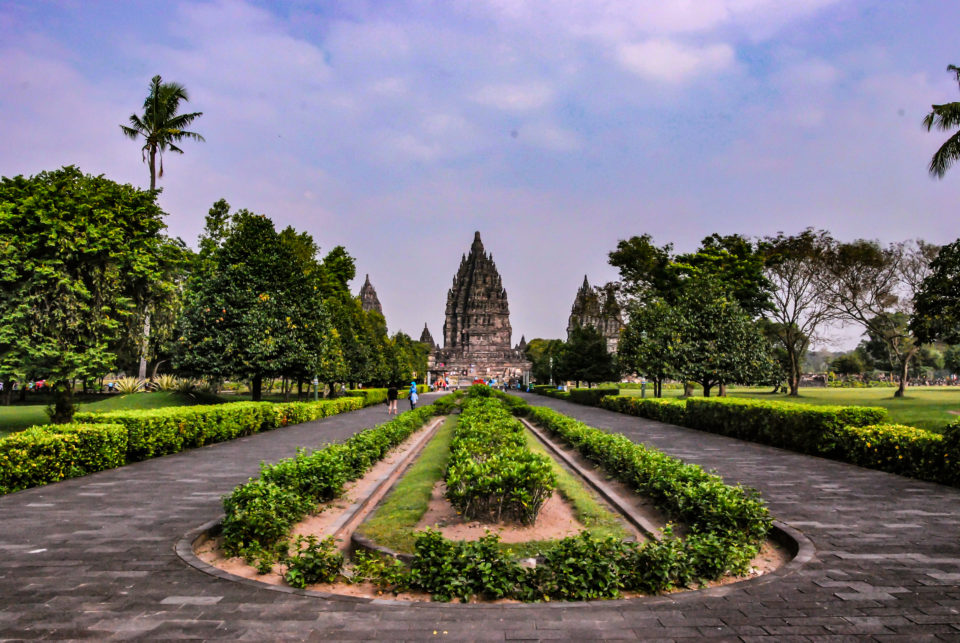
Prambanan temple compounds, named after the village nearby, has 5 major temples complexes and more than 500 temples. The major temple complex is Prambanan temple complex with 240 Hindu temples. Another major temple complex is Candi Sewu, 2nd largest Buddhist temple complex in Indonesia after Borobudur with a total of 249 temples though the striking feature is the massive Dwara balas or protectors of the temple gates. The other temples are Bubrah, Lumbung and Asu. All these temples except Asu are at different stages of restoration by the UNESCO working with the Indonesian Government. Do note that Asu is still buried under the soil due to the impact of Mount Merapi volcano and yet to be excavated.
Prambanan Temple Complex
Prambanan temple complex is the most popular one among these various temples.
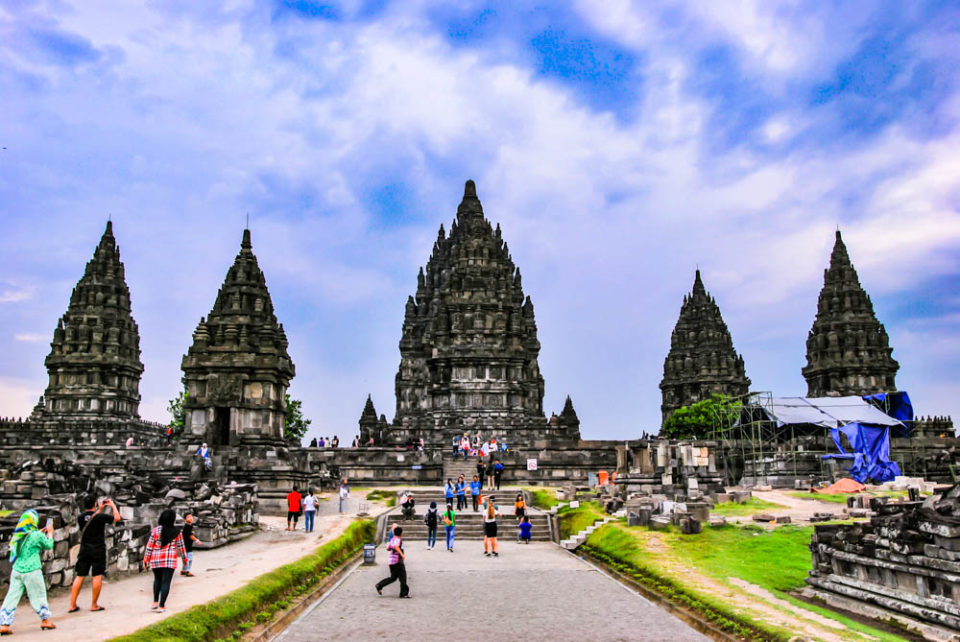
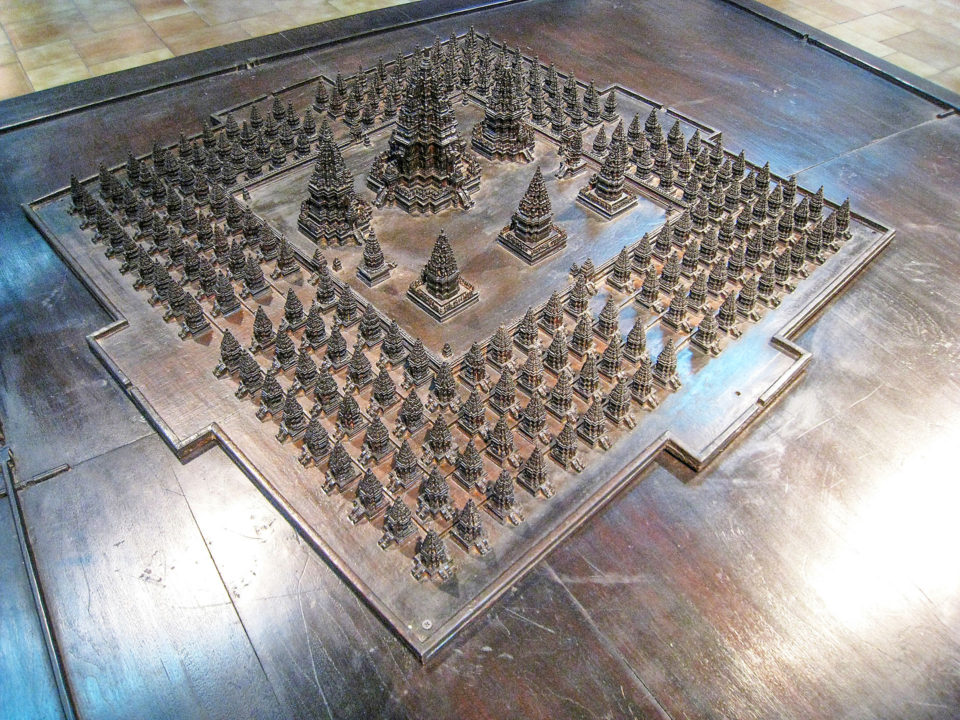
The temple complex as I mentioned above has 240 temples. They are organized as follows
- The 3 main temples for the 3 Murthys of the Hindu religion – Siva, Vishnu and Brahma with the Siva temple in the center.
- Vahana or vehicle temples of the respective Murthys are opposite to each one of the Murthys for a total of 3 temples. The 3 Vahana temples are Garuda, Nandi and Angsa (or swan).
- There are two Apit temples or flank temples on either side of the 6 temples in the center row between the rows of Vahana and Murthy temples.
- There are 4 Kelir temples on four cardinal directions outside the inner courtyard
- Then there are 4 Pathok temples on 4 corners of the inner courtyard
- Then outside all these temples are the Perwara (“waiting woman”) temples organized in 4 concentric squares with different no. of temples from inner square to outer square as follows – 44,52,60,68
The striking feature of Prambanan is the architecture, which is a typical representation of the South Indian Pallava-Chola architecture – It is typical of that architecture to have very tall Vimanas and Gopurams(towers), large courtyards and aesthetically carved bas reliefs. Also the Prambanan temples follow the Mandala concept of the Vastu Shastra, an ancient Indian science of architecture and construction. The inner space with the Murthy temples, the Perwara temples and the space outside Perwara temples make up the 3 Mandala concept of the Vastu Shastra.
Today only the Murthy, Vahana, Apit and Kelir temples has been restored while the Pathok and Perwara are not restored yet though work is in progress.
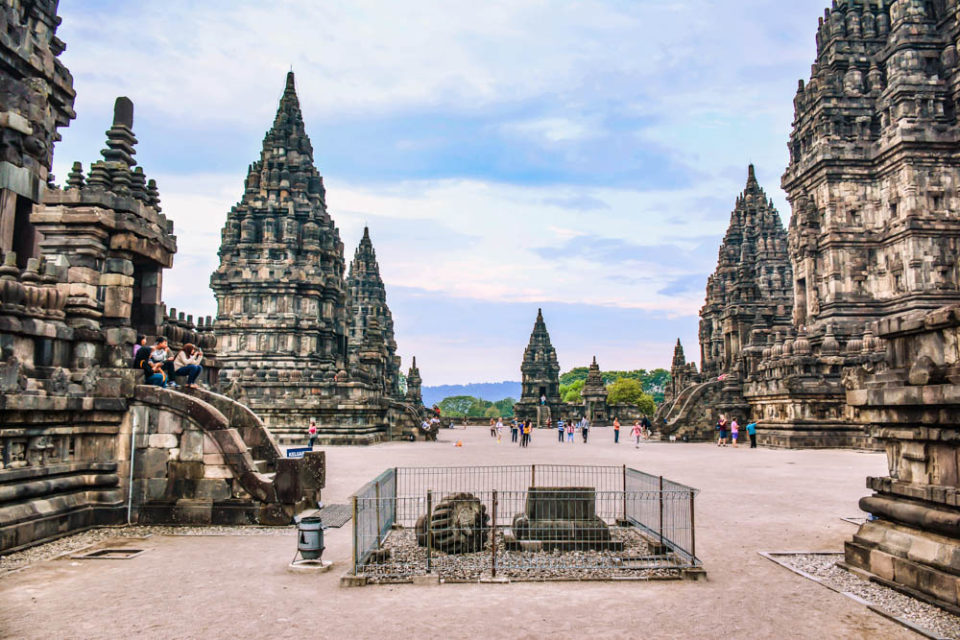
From Left – Clockwise – Garuda temple (people seated in the stairs), Nandi temple, Angsa temple, Kelir temple (straight ahead), Apit temple (smaller one), Brahma temple, Siva temple and Vishnu temple in the right corner
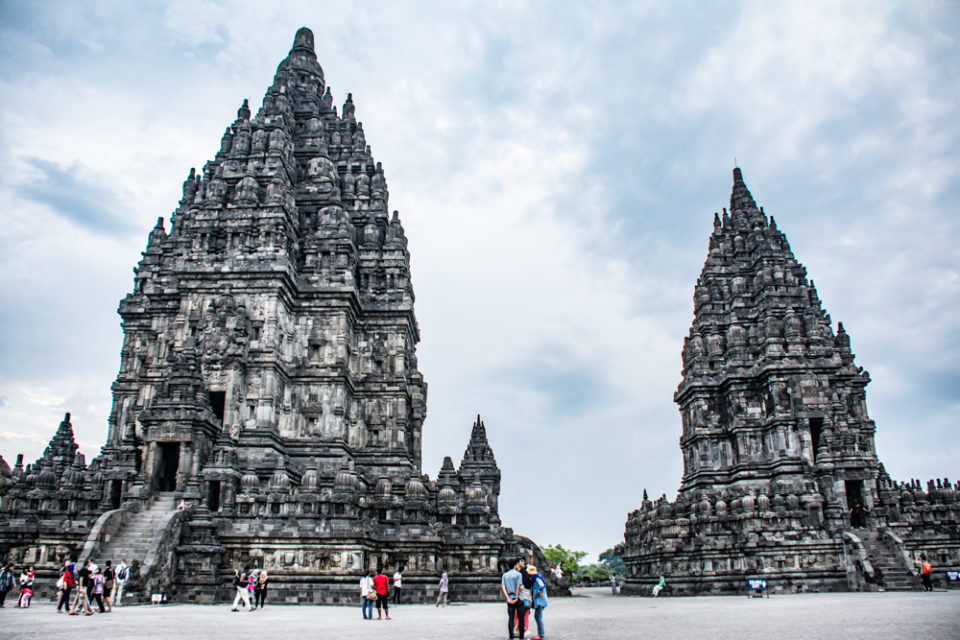
The temples of Prambanan itself are organized as per the Logam concept. The foot of each temple represents the Boologam or the realm of the mortals. The middle realm or the body of the temple represent Bhuvarlogam or realm for the holy people. The upper realm or the holiest part of the temple or the topmost layer is the realm of gods called Swarkalogam. The upper realm is completed by a Vajra (it can mean both thunderbolt or diamond) on the roof.
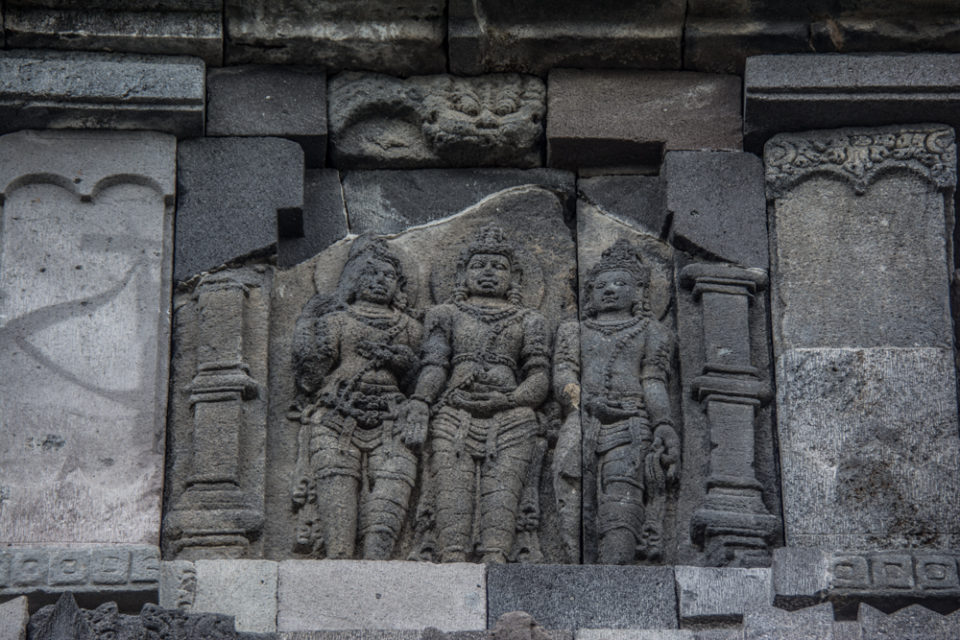
Rama with Lakshmana and Sita Devi
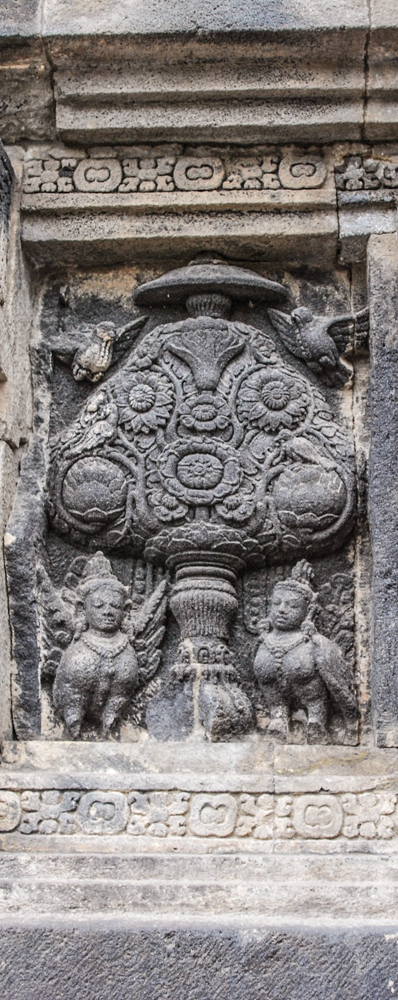
The Bas reliefs of Prambanan is very extensive and narrative. The narrative part is about Ramayana epic and Bhagavata puranam – stories about Vishnu and his avatars. The reliefs also have depictions about Kalpataru, Apsaras, Devadas – all part of the Hindu/Buddhist mythology.
History
The temple is believed to have been built by Rakai Pikatan of Sanjaya dynasty around 850 AD and expanded by subsequent kings building the Perwara temples surrounding the centerpiece in concentric squares. At its peak, hundreds of Brahmins lived in the temple complex while the royal court with the urban center was located nearby. The royal court was shifted either due to Mount Merapi volcano eruption or due to power struggle throwing Prambanan into disuse. The locals knew about the existence of the temple but did not know the background and so the folklore of Roro Jonggrang was attached to the temple.
It was rediscovered in the early 19th century by archaeologists from Britain during its short occupation.
Folklore of Roro Jonggrang
Candi Prambanan is also called as Candi Roro Jonggrang based on the folklore in these parts of the island. Roro Jonggrang is the story of a princess by the same name and her love and betrayal. The other architectural sites existing today, Ratu Boko, Candi Sewu temple complex and the statue of Durga Mahishasuramardini within Prambanan temple complex all have their mythical connections to this story. Father of Roro Jonggrang, Prabu Boko was killed in a battle by neighboring kingdom’s prince, Bandung Bondowoso. Prince Bondowoso along with his army captures the Ratu Boko palace. On seeing Princess Roro Jonggrang, he falls in love with her and wishes to marry her. Roro Jonggrang, not wishing to marry him for he being her father’s killer but at the same time does not want to reject him for him being the victor, places an impossible condition to be fulfilled by the prince – build a 1000 temples in a night. But Prince Bondowoso, has the magical powers to invoke demon spirits (kind of like Genies) to build the 1000 temples. But the demon spirits can only work in the night as the sunlight can burn these spirits during daytime. They proceed to build the temples and had completed 999 temples when the princess hears this news. She tricks the rooster in the Palace by having the maids light candles on the eastern side. The rooster, thinking that the sun was rising, starts to crow and the spirits rush back to below the earth. Prince Bondowoso tries to build the 1000th temple but fails. In his anger at being tricked, he curses the Princess, who becomes a statue in the Prambanan temple complex, that of the statue of Durga.
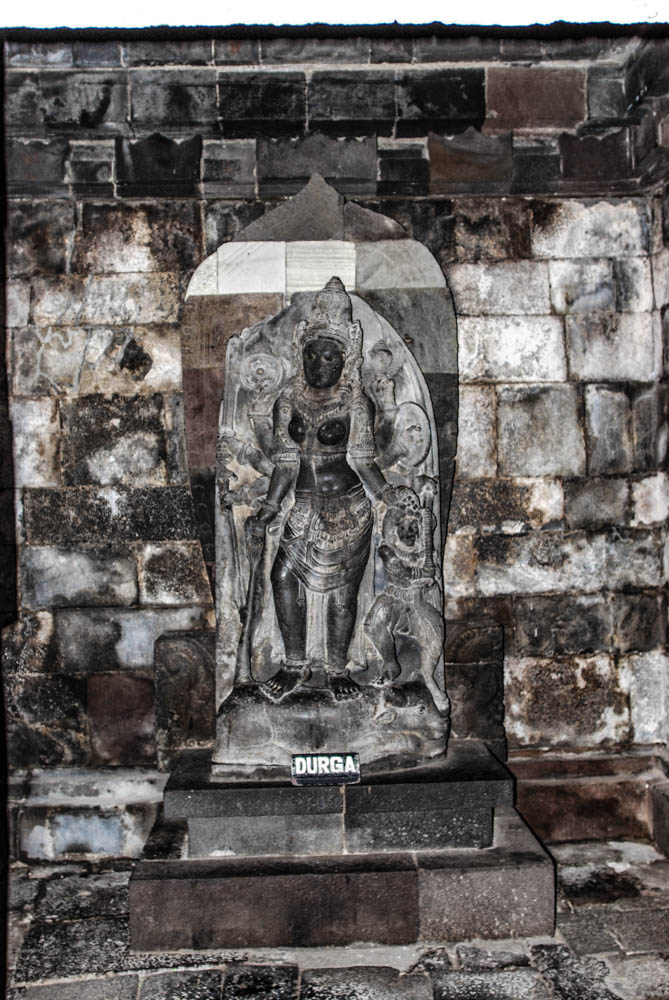
Candi Bubrah
Thoroughly savoring the great architecture of Prambanan and wanting to visit the temple another day (which I did 2 days later), I walked hundred or so meters to Candi Bubrah, which is a Buddhist temple constructed in the 9th century by the Sailendra dynasty. It is named as Bubrah as it was discovered in complete ruins. What exists today is a 12 meters x 12 meters platform where I could see works carried on to restore this temple. As per my conversation with the workers, the temple is made up of volcanic rocks.
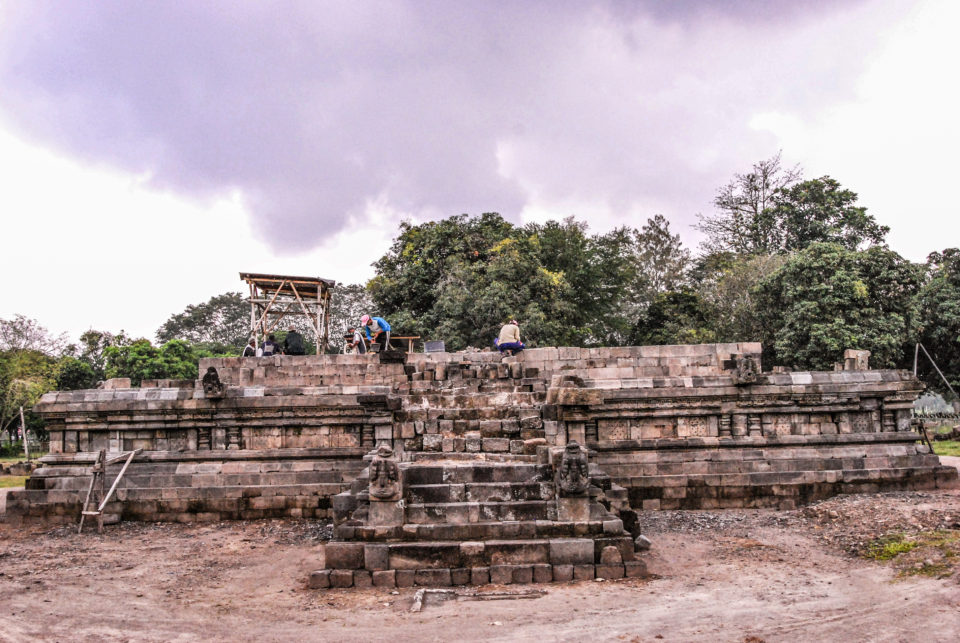
Candi Lumbung
As there was not much to be seen, I hardly spent 15 minutes in Candi Bubrah and walked to my next temple – Candi Lumbung. Candi Lumbung was built around the same time frame as Candi Bubrah in the 9th century by Sailendra Dynasty but predates Prambanan temple. The main temple is a Buddhist temple dedicated to Manjushri Bodhisattva. There are 16 Perwara temples similar to the Perwara temples of Prambanan. On top of the main temple is the stupa, typical of a Buddhist temple. The main temple can be accessed from the 4 cardinal points. Just like other temples in the compounds, Lumbung is going through renovation but is in a better condition than Bubrah.
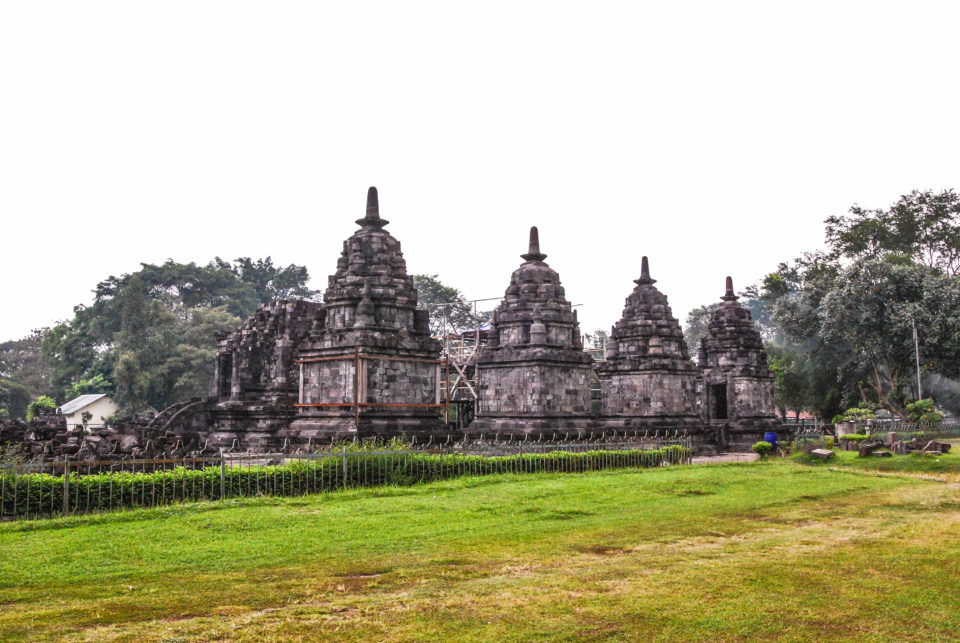
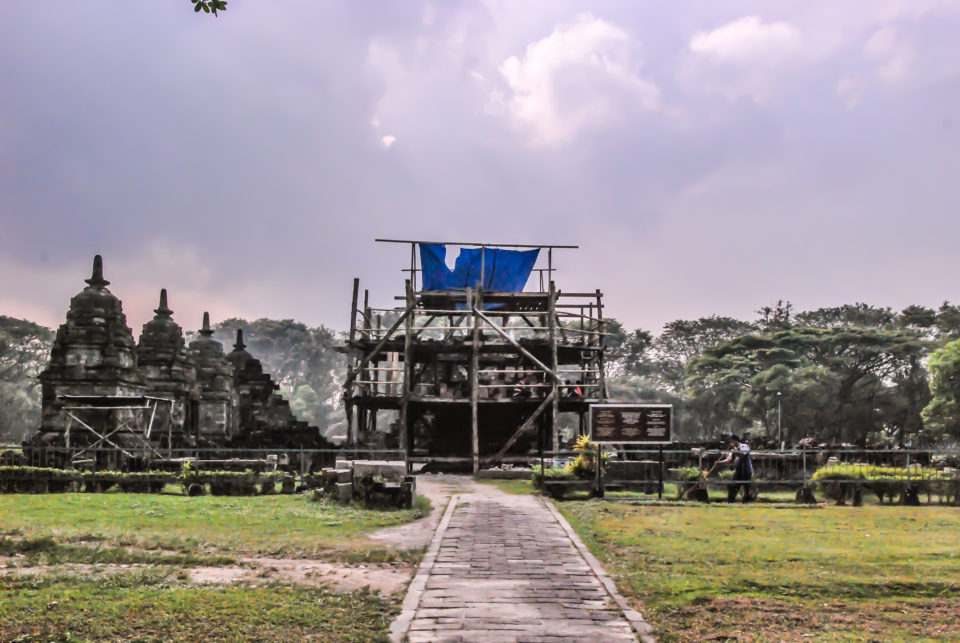
Candi Sewu
After visiting Lumbung, I walked few hundred meters to stop by Candi Sewu, which is a large temple complex unlike the smaller ruins of Bubrah. As I mentioned above, it is the 2nd largest Buddhist temple complex in Indonesia after Borobudur with a total of 249 temples in its complex. The architecture more resembles the Pala architecture due to the Perwara temples arranged in a geometric fashion similar to Prambanan. But Sewu predates Prambanan by at least a century. The original name for this temple was Manjusrigrha (meaning “house of Manjushri”) and was dedicated to Manjushri Bodhisattva similar to the Lumbung temple nearby.
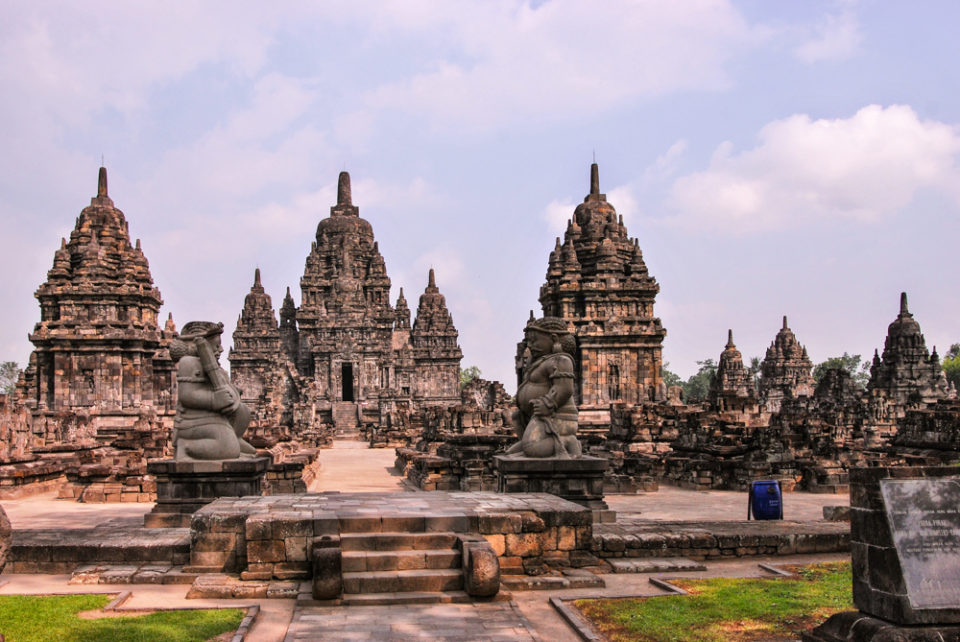
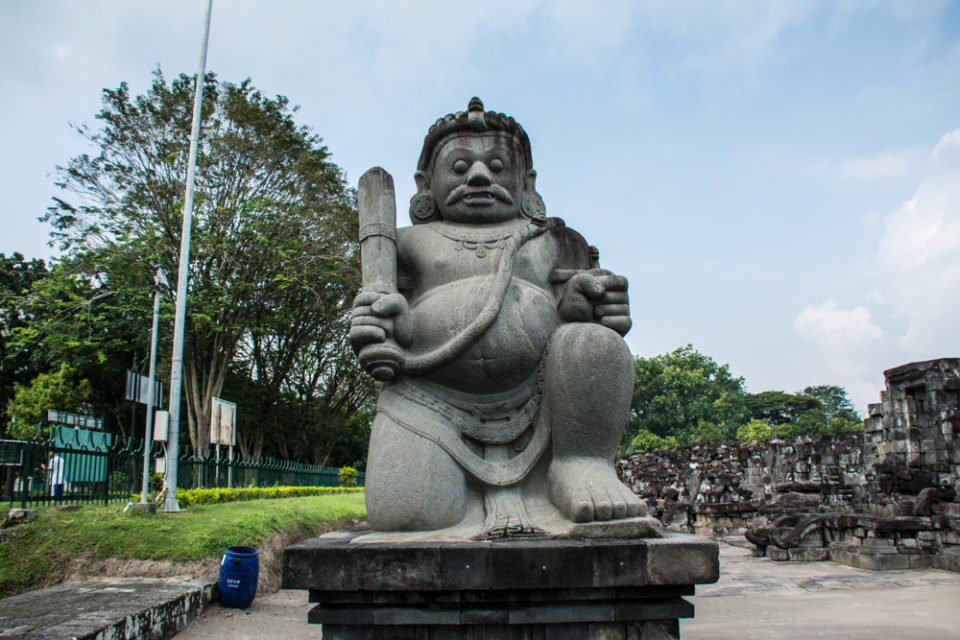
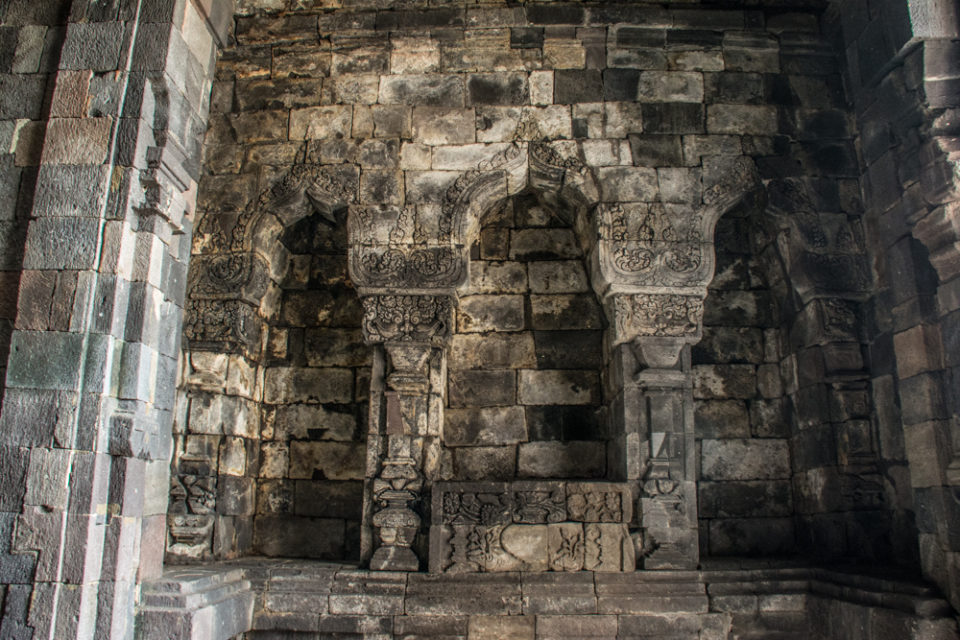
The main temple itself is 30 meters in height and 29 meters in diameter and is in a 20 sided Polygon shape. The temple was believed to have had a bronze statue of Manjushri. The main temple is surrounded by 4 concentric rows of Perwara temples similar to Prambanan and the temple complex itself follows the same Vaastu-based Mandala concept. Candi Sewu shares its Folklore of Roro Jonggrang with the Prambanan as many associate it with this temple complex.
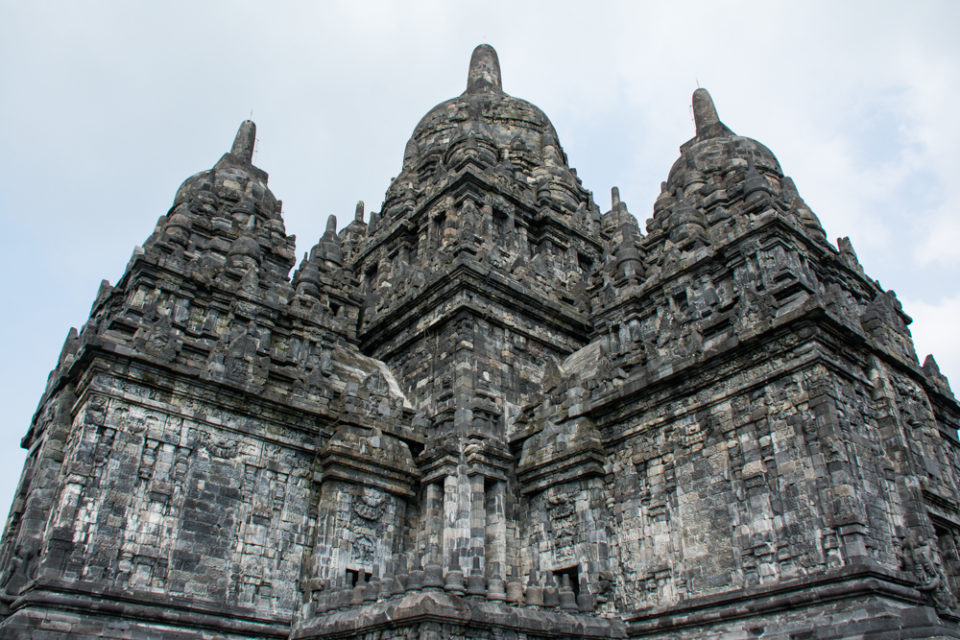
Few of the 20 corners of the main temple visible
Hema and I went our different ways exploring the temple in isolation. I was in a meditative state engrossed by the spirituality and was in total peace with myself. But soon I was awakened by a group of noisy school kids with their teacher explaining the history. That was the sign for us to head back to the hotel having been thoroughly exhausted by the hot sun. We headed back to the entrance and took a tuk-tuk (autorickshaw as they are called in these regions) to our hotel to savor another day of the cultural and spiritual experience in Borobudur. (to be covered in the next part)
How to get there?
Prambanan is situated 20 minutes from the Yogyakarta international airport. It costs around 70000 Indonesian Rupiah (conversion rate is roughly 13000 Rupiah to 1 USD at the time of writing this article) in taxi from the airport to Prambanan. Low cost airlines fly to Yogya from other parts of Indonesia. To give one a ballpark no, ticket from Denpasar, Bali cost me around $35 USD one way. Do note that the local airlines do not taken foreign credit cards. So you can’t book tickets online. Just go to their office to book the local flights to these places. The price from what I noticed remains the same whether you book it 2 months in advance or 1 day in advance. It is around $35-$40 one way to different destinations. I went to Denpasar office – all the local airlines’ desks are in the airport and seated next to each other. I paid them cash and booked my local flights.
Where to stay?
There are hotels and resorts around the Prambanan temple complex with various prices from the budget to the expensive ones. Based on my personal experience, Poeri Devata resort, which I happened to book for roughly $38 per night is an excellent choice due to the friendly staffs. The hotel is situated on the backside of the Prambanan complex but the hotel provides free ride to the Prambanan temple entrance. The entrance fees for foreigners is $17 which covers all the temple complexes within the Prambanan compounds i.e. Sewu, Prambanan, Bubrah, Lumbung. Also the hotel offers motorcycle for rent at 10000 rupiahs per hour. The other option is to stay in Yogyakarta but I recommend staying in Prambanan as there is easy access to other archaeological complexes like Ratu Boko palace, Candi Sambisari, Candi Plaosan, Candi Kalasan, Candi Sari and one can visit these sites with the motorcycle.

Travel around
There are options available to travel around Prambanan. Taxis, Motorized rickshaws, buggies or scooter rentals are the options available. Needless to say, renting a scooter is the cheapest mode of transportation. Do carry International driving permit for a motorcycle to avoid any unpleasant encounters with the police.
Special Tips & Warnings
Do not miss the Ramayana Ballet – Wayang Wong, which happens with Prambanan temple in the background. This is the best depiction of the Javanese dance, drama, music, literature. In the months of May to September, the Ballet is conducted outdoor while during the rainy months of October to April, it is conducted in an indoor auditorium.
Also Read:
Central Java – Epitome of Dharmic Architecture in SE Asia – Part 2 – Borobudur
Central Java – Epitome of Dharmic Architecture in SE Asia – Part 3 of 3


One of the seven wonder in the world, thanks for sharing
Thankyou for your comments.